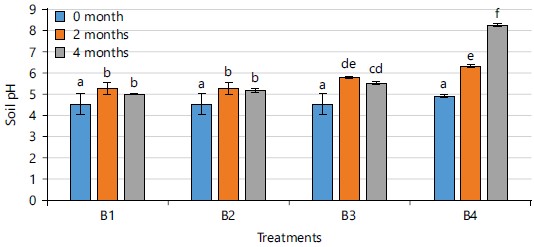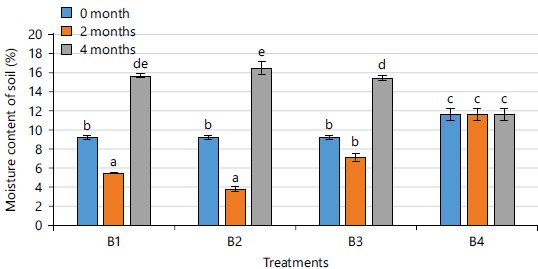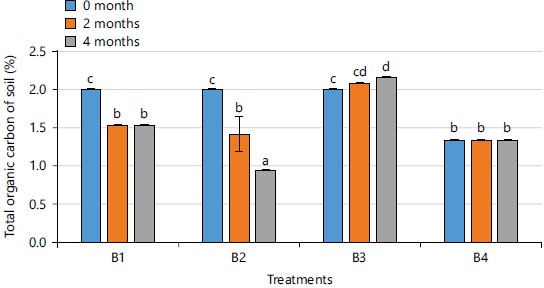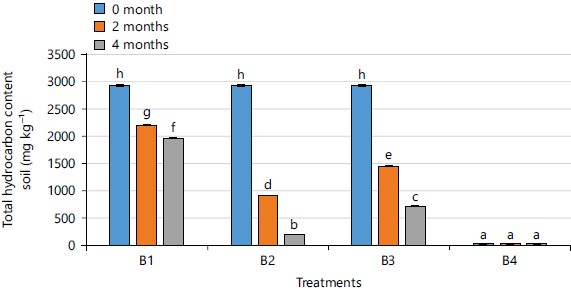Effect of Urea Application on Soil Properties and Hydrocarbon Reduction in Crude Oil Contaminated Soil
| Received 29 Jul, 2022 |
Accepted 01 Apr, 2023 |
Published 30 Jun, 2023 |
Background and Objective: Soil contamination resulting from crude oil spills poses an environmental threat in the Niger Delta Area of Nigeria and the world at large and the remediation of oil-polluted soil is one of the major problems for environmental research. This study investigated the effect of urea as an amendment (remediating material) on soil properties and hydrocarbon reduction in crude oil-contaminated soil at Botem-Tai in Rivers State, Nigeria. Materials and Methods: A Randomized Complete Block Design (RCBD) was used and the experimental treatment were: B1: Polluted soil without urea, B2: Polluted soil with 20 g urea addition, B3: Polluted soil with 40 g Urea addition, B4: Unpolluted soil. Physical-chemical and microbial analyses were done on soil samples from the different treatment plots. Results: The significant reductions (p = 0.05) in Total Hydrocarbon Content (THC) and Total Petroleum Hydrocarbon (TPH) of polluted soil with urea addition (B2: 193.98 and 135.90 mg kg‾1 and B3: 708.13 and 615.40 mg kg‾1) compared to the polluted without urea (B1: 1963.67 and 1014.37 mg kg‾1) as against the initial of 2926.00 and 1189.96 mg kg‾1 recorded. Conclusion: Hence, the use of urea in in situ remediation of crude oil-polluted soil proved effective.
| Copyright © 2023 Keayiabarido and Tanee. This is an open-access article distributed under the Creative Commons Attribution License, which permits unrestricted use, distribution, and reproduction in any medium, provided the original work is properly cited. |
INTRODUCTION
Accidental spills and leakages that occur during the exploration, refining, transportation and storage of petroleum and its products affect the environment1. It causes physical, chemical and biological damage to the affected environment (land, water and air) thus soil contamination with petroleum compounds is of great concern worldwide. Crude oil contamination poses serious environmental problems2 resulting in different health challenges and economic loss3. The environmental impact includes pollution of groundwater limiting its usage, soil degradation and decreases in agricultural productivity4,5 of the soil which in turn affects food production and the life-li-hood of inhabitants. With reference to all the negative effects of oil pollution in soil, the remediation of affected soil is necessary. Different methods have been adopted for the remediation of petroleum-contaminated soil which includes, natural attenuation, physical/mechanical methods, chemical methods and biological methods.
Contaminated soil naturally undergoes self-remediation (recovery) over time, a process known as natural attenuation. This method is slow and takes a longer time for remediation of a contaminated site to be achieved. Physical/mechanical and chemical remediation are general methods for the remediation of sites contaminated by petroleum compounds6. These methods, however, have some negative effects on the environment and are costly6,7. Presently oil removal from contaminated soil by biological methods referred to as bioremediation (bio-stimulation, bio-augmentation, phytoremediation) is required. Though remediation can occur naturally takes time thus, the recovery of impacted soil is accelerated through the addition of microbes and fertilizers.
Bioremediation is the addition of materials to contaminated environs (soil) to accelerate the natural biodegradation process. Bioremediation of contaminated soil is simpler, requires less labour, causes less impact on soil structure and is highly accepted by the public as compared to other methods8,9. The Hydrocarbon biodegradation process in the soil is limited by so many factors including nutrients, oxygen, pH, temperature, moisture, soil characteristics, microorganisms and pollutants concentration. Biostimulation which is an approach in bioremediation involves reform (modification) of the environment which is usually done by the addition of amendment materials to stimulate existing bacteria capable of bioremediation.
Nutrient addition is essential in the achievement of the nitrogen/carbon equilibrium and successful biodegradation of hydrocarbon. Reports of researchers have confirmed that the application of fertilizer on crude oil contaminated soil gives rise to an increase in the rate of biodegradation of the pollutant. According to the report from the research work of Agarry10, increased degradation of contaminants was recorded in contaminated soils with fertilizers added. The choice of urea as a source of nitrogen supply in the soil to enhance the degradation or breakdown of hydrocarbon is on the basis that it has a high amount of nitrogen and is commercially available.
This study aimed to evaluate the effect of the application of urea on soil properties and hydrocarbon reduction in crude oil-contaminated soil. Findings from this study will offer additional options for remediating petroleum polluted soils.
MATERIALS AND METHODS
Site description: The study was carried out from April to August in the year 2018 at a crude oil polluted site (GPS: N 4°43'29.56082") which resulted from an oil spill and a non-polluted site (E 7°16'8.382") with no evidence of crude oil pollution at Botem-Tai in Tai Local Government Area of Rivers State, Nigeria. The oil spill resulted from a leakage in a petroleum pipe belonging to Shell Petroleum Development Company (SPDC). The site was a level ground made up of sandy-loam soil type.
Mapping of experimental site: The two different sites (polluted and non-polluted) were mapped out for the study. The polluted site of area of 14 m x 10 m was subdivided into nine sub-plots of 2×2 m each with an interval of 2 m between them. Then 20 and 40 g of urea obtained from the Agricultural Development Program (ADP) Rumuodomaya, Port Harcourt, Rivers State were dissolved in water and added to the respective subplots. The non-polluted site was located at a distance of 30 m away from the polluted site. This was also subdivided into three replicated plots as shown in Fig. 1.
Experimental design: A Randomized Complete Block Design (RCBD) consisting of four treatments in four blocks was used for the experiment. Each treatment was represented in each block and the treatments replicated three times. The four treatments were as follows:
• |
B1: |
Polluted soil without urea |
|
• |
B2: |
Polluted soil with 20 g urea addition |
|
• |
B3: |
Polluted soil with 40 g urea addition |
|
• |
B4: |
Non-polluted soil |

|
Soil sampling: Soil samples were collected from the sampled sites with a soil auger at three different times for analysis of soil physico-chemical properties (pH, conductivity, soil moisture, total nitrogen, total organic, total organic matter, potassium, phosphorus, total petroleum hydrocarbon and total hydrocarbon content) and population of microorganisms in soil were analysed, firstly, before the amendment (urea) addition, secondly after 2 months post amendment addition and thirdly after 4 months post amendment addition. The result initially obtained from the unpolluted soil served as a baseline for the study.
Determination of soil physico-chemical properties: Soil pH and conductivity were determined using an electrode pH meter (PHS. 25 Model) and conductivity meter (Labtech Model), respectively. Soil moisture content was determined by the air oven method used by O’Kelly11. Kjeldahl Method as outlined by Jude and Tanee12 was used to determine the total nitrogen and nitrate of soil. Walkley-black method cited by Tanee and Jude13 was used to determine total organic carbon and potassium in soil. The total Organic matter content of the soil was determined by calculation, using the formula outlined by Osuji et al.14. Bray No. 1 method used by Jude et al.15 was used to determine available phosphorus in the soil. The API-RP45 colorimetric method used by Tanee and Jude13 was used to determine the Total Hydrocarbon Content (THC) of soil while the Gas Chromatography/Mass Spectrometry (GC/MS) method cited by Faustorilla et al.16 was used to determine the Total Petroleum Hydrocarbon (TPH) in soil. Baath and Anderson’s method used by Jude et al.17 was used to determine the microbial population (total heterotrophic bacteria, total fungi, hydrocarbon-utilizing bacteria and hydrocarbon utilizing fungi) of soil.
Statistical analysis: Means and standard error means were calculated from the data generated and were further analyzed statistically using two-way Analysis of Variance (ANOVA). The Least Significant Difference (LSD) was determined using the 2018 version of the Duncan’s Multiple Range Test and results were presented as Mean±Standard Error (SE) using histograms and table. The significance level was at p = 0.05.
RESULTS
Results for soil pH and conductivity were presented in Fig. 2 and 3. Significant increase in soil pH (decrease in acidity) in all the polluted soil after amendment with urea, with highest increase recorded in B3 (polluted soil with 40 g urea addition). For soil conductivity, the reverse was the case, decrease in soil conductivity was observed in urea amended soil except in B3 where significant increase was observed at 2 months after amendment (Fig. 3).
Figure 4 showed that moisture content of polluted soil without amendment (B1) was lower than that obtained in the unpolluted soil (B4). At 2 months, moisture content decreased in all polluted soil (B1, B2 and B3) while that of the unpolluted soil (B4) remain the same. At 4 months, soil moisture content also increased in polluted soil, with or without amendment (B1, B2 and B3) except in the unpolluted soil. There was significant difference between increase in moisture content in treatment B2 and B3 at 4 months (p = 0.05).
Figure 5 and 6 showed the result for total nitrogen and nitrate in soil. Nitrogen and nitrate significantly increased in B3 (polluted soil with 40 g urea addition) (p = 0.05) while decreases were observed in treatment B1, B2 and unpolluted soil (B4). At the termination of the study (4 months).
Similar result of conductivity was obtained for the Total Organic Matter (TOM) and Total Organic Carbon (TOC) where amendment (urea) reduced the TOM and TOC of the soil except in B3 (polluted soil with 40 g urea addition) were increase were observed (Fig. 7 and 8).

|

|

|

|

|
The result for soil phosphorus was presented in Fig. 9 showed an increase in phosphorus of all polluted soil (without or with urea addition (B1, B2 and B3). Highest increase in soil phosphorus was observed in B1 (polluted soil without urea) at 2 months after urea application. There was significant difference in soil phosphorus of B1 and other treatments (B2, B3), p = 0.05. At 4 months, increase in phosphorus decreased in B1 and B2 while there was slight increase observed in B3 compared to that observed at 2 months.

|

|

|

|

|
Result for potassium (Fig. 10) showed significant increase in soil potassium of polluted soil without urea (B1) and polluted soil with 20 g urea addition (B2) while that of polluted soil with 40 g urea addition (B3) decreased at 2 months. There was significant difference in increase potassium between B2 and B1 at 2 months (p = 0.05). At 4 months, potassium decreased in all treatments except in the unpolluted soil (B4).
The result presented in Fig. 11 and 12 showed that soil Total Petroleum Hydrocarbon (TPH) and Total Hydrocarbon Content (THC) of the polluted soil were significantly (p = 0.05) reduced in the amended polluted soil with treatment B2 (polluted soil with 20 g urea addition) having the highest reduction while least reduction in soil TPH and THC was observed in polluted soil without urea (B1) at both 2 and 4 months.
The results for microbial count in the different treatments was shown in Table 1. Total Heterotrophic Bacteria (THB) increase in polluted soil amended with urea (B2 and B3) as compared to polluted soil without urea addition (B1) at 2 months. Between polluted soil with urea addition, 40 g urea (B3) had the highest THB population. Polluted soil without urea (B1) had higher fungal population than polluted soil with amendment. At 4 months, increase in TF (total fungi) was observed in polluted soil with 20 g urea addition (B2) while decrease was observed in treatments (B1, B3 and B4). Highest Hydrocarbon Utilizing Bacteria (HUB) count was obtained in polluted soil with 40 g urea addition (B3). At 4 months, decrease in HUB count was observed in polluted soil with urea addition (B2 and B3) as compared to polluted soil without urea (B1). Highest HUF population was recorded in polluted soil with 40 g urea addition at 2 months.

|
| Table 1: | Microbial population in the soils amended with urea | |||
THB (CFU g–1) |
HUB (CFU g–1) |
TF (CFU g–1) |
HUF (CFU g–1) |
|||||||||
| Treatment | 0 month |
2 months |
4 months |
0 month |
2 months |
4 months |
0 month |
2 months |
4 months |
0 month |
2 months |
4 months |
| B1 | 8.4×105 |
8.0×104 |
3.8×106 |
4.0×104 |
4.4×105 |
8.5×105 |
3.7×104 |
4.5×106 |
4.0×105 |
3.2×104 |
7.5×105 |
6.3×104 |
| B2 | 8.4×105 |
3.3×106 |
2.5×107 |
4.0×104 |
1.2×106 |
5.5×105 |
3.7×104 |
1.0×104 |
1.1×105 |
3.2×104 |
1.5×105 |
6.4×104 |
| B3 | 8.4×105 |
6.0×106 |
1.2×106 |
4.0×104 |
1.1×106 |
5.4×105 |
3.7×104 |
6.5×104 |
1.6×104 |
3.2×104 |
5.0×106 |
1.4×105 |
| B4 | 1.3×106 |
1.3×106 |
2.6×106 |
5.3×104 |
5.3×104 |
8.5×105 |
4.3×104 |
4.3×104 |
2.7×104 |
4.2×104 |
4.2×104 |
2.3×104 |
| B1: Polluted soil without urea, B2: Polluted soil with 20 g urea addition, B3: Polluted soil with 40 g urea addition, B4: Unpolluted soil, THB: Total heterotrophic bacteria, HUB: Hydrocarbon utilizing bacteria, TF: Total fungi and HUF: Hydrocarbon utilizing fungi | ||||||||||||
DISCUSSION
Hydrocarbon pollution in soil has rendered soils of affected land unproductive, thus the need for remediation and subsequent restoration of such land. Though the degradation of this pollutant can occur naturally, it is slow and takes a longer period to recover affected land. Thus bioremediation using remediating materials which accelerate the pollutant degradation process is necessary. The addition of urea which served as source of nutrients stimulated naturally occurring or indigenous microorganisms in the soil. Samples showed an apparently higher rate of hydrocarbon reductions18.
In this study, the addition of urea in crude oil-polluted soil facilitated the degradation of hydrocarbon as higher reductions of total petroleum hydrocarbon and total hydrocarbon content were obtained in polluted soil in which urea was added. The addition of urea enhanced the solubility and removal of the contaminant, improving the oil biodegradation rate. Agarry10 had a similar observation and concluded that fertilizer application increased the degradation of the hydrocarbons compared with the control.
An increase in soil pH (decrease in acidity) in the amended soil provided a favorable pH for oil-degrading microorganisms to act. This is because most microbial activities occur at a pH close to neutrality. An increase in soil conductivity observed in polluted amended soil may be linked to urea which stimulated TPH and THC reduction and subsequent increase in conductivity of the soil. An Increase in total organic carbon and total organic matter observed in polluted soil with urea could be attributed to the urea (remediating agent) decomposition19. This justified urea as an amendment in improving soil properties. Higher TPH and THC reduction were observed. The increase in total organic matter and total organic carbon in the polluted soil with urea addition, supplement the limiting nutrients, thus, providing favorable condition for microbial growth and actions which was earlier stated in the report on biostimulation by Udume et al.20. This also confirmed the work of Jude and Tanee12, who reported that total organic matter and carbon increase in polluted amended soil.
The application of urea boosts the growth of microbes with the potential to degrade petroleum contaminants (hydrocarbons) hence the reduction of hydrocarbon recorded. an indication that adding a nitrogen source (such as urea) is capable of boosting pollutant biodegradation21. Similarly, Agarry10 reported a rise in population of microbes with the ability to breakdown pollutants in impacted soil treated with NPK fertilizer. An Increase in total nitrogen and nitrate recorded in urea amended polluted soil may be linked to input from urea, an inorganic fertilizer having nitrogen as it’s only constituent. This was in line with Tanee and Kinako22, who in a similar study observed the highest phosphate and nitrogen concentration in polluted soil (plots) treated with NPK fertilizer. An Increase in phosphorus and potassium in amended soil may have resulted from the reduction in TPH and THC, an indication that urea addition improved soil properties previously altered by crude oil contamination. Similar observation has been reported from the study of Tanee and Jude13.
An Increase in Total Heterotrophic Bacteria (THB) observed the polluted soil amended with urea may be attributed to urea addition which increased soil nitrogen. The release of nitrogen into the soil by urea addition speed up the degradation of hydrocarbon. This was in line with the report of Dashti et al.23 and Bell et al.24 that nitrogen amendment is found to be one of the most efficient biostimulation approaches which speeds up efficient oxidation of carbon substrates, microbial growth and subsequent breakdown of hydrocarbon. Similarly, Babalola et al.21 reported high microbial biomass in urea amended soil.
Hydrocarbon reduction and improvement of soil properties in crude oil polluted sites is achievable through remediation using urea which implies that urea is an effective bio-remediating agent as it fast tracked the recovery of crude oil polluted land. Though the study was a pilot work with a limited land space and small quantities of urea in which only 10 and 20 g m–2 were investigated, other levels/quantity of urea can also be tried for their effectiveness. It is therefore, recommended that the research be carried out on a large scale and the use of 20 g urea/2 m2 be adopted as higher reduction of hydrocarbon was observed with its usage.
CONCLUSION
Crude oil reduces soil fertility and productivity of biotic components in any impacted area and such polluted soil could be recuperated or recovered by natural attenuation but this process is slow. The use of urea as a remediating agent (material) in the biodegradation of crude oil polluted sites is effective as observed in this study. The urea addition in polluted soil boosted the biodegradation of hydrocarbon significantly. This is an indication that remediation by enhanced natural attenuation using urea is efficient and promises to be one of the best options in the remediation of crude oil polluted soil.
SIGNIFICANCE STATEMENT
This study discovered the efficacy of urea in the improvement of soil properties and stimulation of speedy reduction of hydrocarbon in crude oil polluted soil. This study will help the researchers to uncover the critical areas of remediation that many researchers were not able to explore. Thus a new theory on the use of urea for in situ bio-remediation of crude oil polluted soil may be arrived at.
REFERENCES
- Benson, D.M., E.B. Ochekwu and F.B.G. Tanee, 2016. Enhancement of crude oil polluted soil by applying single and combined cow-dung and hydrogen peroxide as remediating agents. J. Appl. Sci. Environ. Manage., 20: 1137-1145.
- Tanee, F.B.G. and E. Albert, 2015. Reconnaissance assessment of long-term effects of crude oil spill on soil chemical properties and plant composition at Kwawa, Ogoni, Nigeria. J. Environ. Sci. Technol., 8: 320-329.
- Elum, Z.A., K. Mopipi and A. Henri-Ukoha, 2016. Oil exploitation and its socioeconomic effects on the Niger Delta Region of Nigeria. Environ. Sci. Pollut. Res., 23: 12880-12889.
- Emmanuel, I.O., O.D. Gordon and A.F. Nkem, 2006. The effect of oil spillage on crop yield and farm income in Delta State, Nigeria. J. Cent. Eur. Agric., 7: 41-48.
- Wang, J., Z. Zhang, Y. Su, W. He, F. He and H. Song, 2008. Phytoremediation of petroleum polluted soil. Pet. Sci., 5: 167-171.
- Asuka, E., H.O. Oku and C.B. Alexander, 2021. Crude oil polluted Niger delta environment: Conservation techniques for survival. Scholars Bull., 7: 252-263.
- Lacalle, R.G., J.M. Becerril and C. Garbisu, 2020. Biological methods of polluted soil remediation for an effective economically-optimal recovery of soil health and ecosystem services. J. Environ. Sci. Public Health, 4: 112-133.
- Agnello, A.C., M. Bagard, E.D. van Hullebusch, G. Esposito and D. Huguenot, 2016. Comparative bioremediation of heavy metals and petroleum hydrocarbons co-contaminated soil by natural attenuation, phytoremediation, bioaugmentation and bioaugmentation-assisted phytoremediation. Sci. Total Environ., 563-564: 693-703.
- Azubuike, C.C., C.B. Chikere and G.C. Okpokwasili, 2016. Bioremediation techniques-classification based on site of application: Principles, advantages, limitations and prospects. World J. Microbiol. Biotechnol., 32: 180.
- Agarry, S.E., 2018. Evaluation of the effects of inorganic and organic fertilizers and activated carbon on bioremediation of soil contaminated with weathered crude oil. J. Appl. Sci. Environ. Manage., 22: 587-595.
- O’Kelly, B.C., 2004. Accurate determination of moisture content of organic soils using the oven drying method. Drying Technol., 22: 1767-1776.
- Jude, K. and F.B.G. Tanee, 2016. Remediation trials of crude oil contaminated soil using different sawdust and detergent combination levels. Sci. Afr., 15.
- Tanee, F.B.G. and K. Jude, 2020. Stimulating the rate of phytoremediation of Chromolaena odorata in crude oil contaminated soil using inorganic urea. Int. J. Plant Soil Sci., 32: 13-25.
- Osuji, L.C., E.J. Egbuson and C.M. Ojinnaka, 2005. Chemical reclamation of crude-oil-inundated soils from Niger Delta, Nigeria. Chem. Ecol., 21: 1-10.
- Jude, K., F.B.G. Tanee and S.I. Mensah, 2019. Enhancing phytoremediation potential of Andropogon tectorum (Schumach & Thonn) in petroleum hydrocarbon contaminated soil using cassava peel. Sci. Afr., 18: 23-36.
- Faustorilla, M.V., Z. Chen, R. Dharmarajan and R. Naidu, 2017. Determination of total petroleum hydrocarbons in Australian groundwater through the improvised gas chromatography-flame ionization detection technique. J. Chromatogr. Sci., 55: 775-783.
- Jude, K., F.B.G. Tanee and A. Ngbaraue, 2022. Use of cassava peel as biostimulant in bioremediation of crude oil-polluted soil. J. Appl. Sci., 22: 351-361.
- Buraimoh, O.M., A.K. Ogunyemi, N.H. Ibrahim, A.S. Adebusoye, M.O. Ilori and O.O. Amund, 2017. Efficacy of intervention strategies for bioremediation of crude oil in polluted soil microcosm. Ife J. Sci., 19: 303-313.
- Ofoegbu, R.U., Y.O.L. Momoh and I.L. Nwaogazie, 2015. Bioremediation of crude oil contaminated soil using organic and inorganic fertilizers. J. Pet. Environ. Biotechnol., 6: 1000198.
- Udume, O.A., G.O. Abu, H.O. Stanley, I.F. Vincent-Akpu, Y. Momoh and M.O. Eze, 2023. Biostimulation of petroleum-contaminated soil using organic and inorganic amendments. Plants, 12: 431.
- Babalola, O.A., M.O. Adigun and I.O. Abiola, 2018. Effect of urea and compost amendments on soil microbial activities and chemical properties. Asian J. Res. Crop Sci., 1.
- Tanee, F.B.G. and P.D.S. Kinako, 2008. Comparative studies of biostimulation and phytoremediation in the mitigation of crude oil toxicity in tropical soil. J. Appl. Sci. Environ. Manag., 12: 143-147.
- Dashti, N., N. Ali, M. Eliyas, M. Khanafer, N.A. Sorkhoh and S.S. Radwan, 2015. Most hydrocarbonoclastic bacteria in the total environment are diazotrophic, which highlights their value in the bioremediation of hydrocarbon contaminants. Microb. Environ., 30: 70-75.
- Bell, T.H., F.O.P. Stefani, K. Abram, J. Champagne, E. Yergeau, M. Hijri and M. St-Arnaud, 2016. A diverse soil microbiome degrades more crude oil than specialized bacterial assemblages obtained in culture. Appl. Environ. Microbiol., 82: 5530-5541.
How to Cite this paper?
APA-7 Style
Keayiabarido,
J., Tanee,
F.B. (2023). Effect of Urea Application on Soil Properties and Hydrocarbon Reduction in Crude Oil Contaminated Soil. Asian Journal of Biological Sciences, 16(2), 121-131. https://doi.org/10.3923/ajbs.2023.121.131
ACS Style
Keayiabarido,
J.; Tanee,
F.B. Effect of Urea Application on Soil Properties and Hydrocarbon Reduction in Crude Oil Contaminated Soil. Asian J. Biol. Sci 2023, 16, 121-131. https://doi.org/10.3923/ajbs.2023.121.131
AMA Style
Keayiabarido
J, Tanee
FB. Effect of Urea Application on Soil Properties and Hydrocarbon Reduction in Crude Oil Contaminated Soil. Asian Journal of Biological Sciences. 2023; 16(2): 121-131. https://doi.org/10.3923/ajbs.2023.121.131
Chicago/Turabian Style
Keayiabarido, Jude, and Franklin Banakuna Godson Tanee.
2023. "Effect of Urea Application on Soil Properties and Hydrocarbon Reduction in Crude Oil Contaminated Soil" Asian Journal of Biological Sciences 16, no. 2: 121-131. https://doi.org/10.3923/ajbs.2023.121.131

This work is licensed under a Creative Commons Attribution 4.0 International License.



